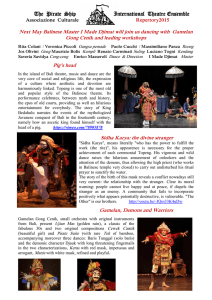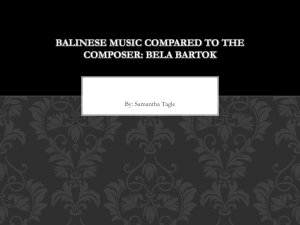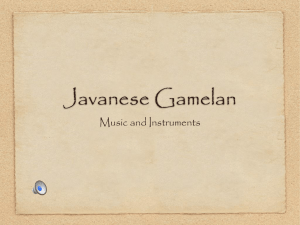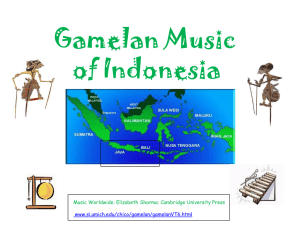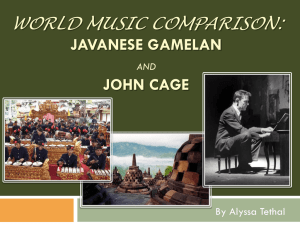PowerPoint Lecture Slides
advertisement
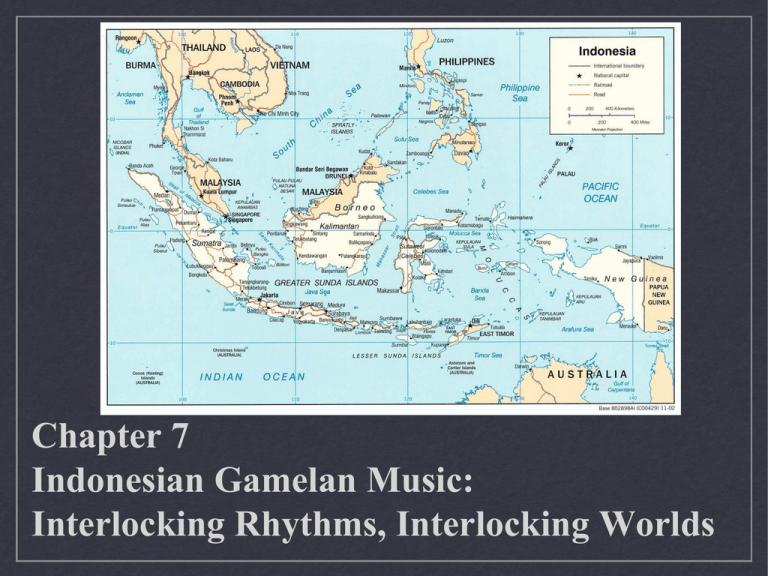
Chapter 7 Indonesian Gamelan Music: Interlocking Rhythms, Interlocking Worlds Bali is a small island in the Southeast Asian nation of Indonesia Hinduism and Buddhism were brought to Bali from Java, blending together with earlier Balinese beliefs to form new religious ideas Bali was colonized by the Dutch in 1906-1908 The Republic of Indonesia gained full independence in 1949 Introduction The term gamelan essentially means ‘ensemble’ or ‘orchestra,’ and refers to a wide variety of percussiondominated musical ensembles in Indonesia Each gamelan contains large numbers of individual instruments, but the gamelan is also considered in its entirety as a single musical instrument Gamelan beleganjur is a processional ensemble traditionally used in warfare, but now associated with many rituals and ceremonies. Balinese Gamelan Music in Context Bali and the Republic of Indonesia Bali is one of 17,000+ islands in Indonesia 3 million people live here Home to an enormous tourist industry The capital of Indonesia is Jakarta, which holds 14 million Indonesia became independent in 1945, gaining full national sovereignty in 1949 The national slogan translates to Unity in Diversity Religion in Bali and Indonesia Indonesia is the largest Islamic nation in the world, both geographically and in terms of population Bali is the only province in which Hinduism is the major religion Balinese Hinduism is a unique mix of Hindusim, Buddhism, and earlier ideas from indigenous Balinese beliefs Gamelan music is central to Balinese Hinduism and is performed at most religious ceremonies Hindu-Balinese cosmology conceives of the universe as having three worlds The Upper world contains the gods and ancestors The Middle World is Bali itself, the earthly realm of the Balinese The Lower World begins where land meets sea and contains evil spirits who pose threats to humankind Insights and Perspectives Bali Aga: The “Original Balinese” and Their Gamelan Music In some villages, people follow indigenous religious faiths that haven’t been largely influenced by Hindusim or Buddhism They are the Bali Aga, or “Original Balinese.” Although Islam is not as influential in Bali as the rest of Indonesia, there are several Balinese villages that are mostly Muslim Gamelan in Bali and Beyond When comparing Central Javanese court gamelan and Balinese gamelan gong kebyar, note that they both generally have: Related instruments (bronze gongs, metallophones, drums, bamboo flutes, bowed chordophones) A basis in cyclic musical forms Related tuning systems Multipart textures in which higher-pitched instruments play at faster rhythmic rates than lower-pitched instruments Melodic organization in which a main, slow melody is embellished by faster-moving parts on other instruments Close associations with forms of dance, dancedrama, and arts like shadow puppetry A common historical foundation in Hindu religious cultures CD ex. #1-7 is a Central Javanese court gamelan piece Evokes the royal pageantry and splendor of the court CD ex. #2-12 is a Balinese example This is an example of kebyar, meaning “to flare up.” Fiery and explosive, it is from the early 20th c. when Balinese society was experiences tremendous social upheaval There are over two dozen distinct types of gamelan found on the tiny island of Bali Some use instruments of iron, hardwood, bamboo, or other substances Some use only voices There are thousands of functioning gamelan clubs on the island Insights and Perspectives The Paired Tuning of Female and Male Instruments Gamelan ensembles feature metallophone instruments called ganga, which come in either one or two pairs in each octave range. Each pair has a “female” and a “male,” in which the female instrument is tuned slightly lower than its male counterpart The instruments may sound out-of-tune, but the difference of pitch is intentional. The blending of the paired instruments creates an acoustical beating effect known as ombak, or “wave.” The Balinese say that the presence of ombak breathes life into the gamelan sound. The Gamelan Beleganjur: An Introduction Listen to Musical Guided Tour One to learn more about the instruments, gong cycle, melodic relationships, interlocking parts, and structure of the music. The foundation is the gong cycle, which repeats throughout the piece. The melodic layer has two components: a core melody and rapid-paced elaborations played upon higher-pitched instruments The final layer is provided by drums and cymbals, which play in complex interlocking patterns. Musical Guided Tour The Gamelan Beleganjur Follow along with the transcript on pages 96-97 of the text as you listen to the Tour for this chapter. Audio Musical Guided Tour Kilitan Telu Interlocking Rhythms: A Musical Symbol of Communal Interdependence The interlocking texture of the percussion instruments, known as kilitan telu, is symbolic of broader Balinese cultural values like communal interdependence. The individual rhythms employed in kilitan telu are seen as incomplete without the others: each one needs the other two rhythms. When played together, the whole kilitan telu is greater than the sum of its individual parts. Balinese Kecak and the Kilitan Telu Kecak is a Balinese dance-drama with music provided by a gamelan of voices The musical texture includes a rhythmic chorus and gamelan gong cycles, melodies, and textures imitated vocally. Onomatopoeic syllables represent gamelan instruments (“sirr,” “pur,” “mong”) Reenacts episodes from the Ramayana, a grand Hindu epic. Results from a collaboration with Balinese musicians and a German painter in connection with a 1933 film, and is now largely marketed for touristic purposes Listen to CD ex. #2-13 for an excerpt of a Kecak performance Experiencing Balinese Interlocking, Kecak-Style 1 2 3 4 5 6 7 8 (1) Pung X . . . X . . . (X) Chak 1 X . X X . X X . (X) Chak 2 . X . X X . X X (.) Chak 3 . X X . X X . X (.) The Gamelan Beleganjur in Battles of Good versus Evil Balinese individuals and communities have concern for perceived threats from malevolent spirit beings Balinese lore claims that the gamelan beleganjur was created by the evil spirits of the Lower World, but was later transformed as a force for good by the Middle World Balinese. The gamelan beleganjur is used as a source of mediation between the three worlds of the Balinese cosmos In rituals like cremation processions, beleganjur music is used to intimidate malevolent spirits who travel the Middle World to do harm to humans. Beleganjur Music in HinduBalinese Cremation Processions Cremation is seen as an essential step for freeing the soul from the earthly realm. The body or exhumed remains are ritually prepared and transported in an enormous cremation tower to the Temple of the Dead. The procession is seen as perilous, and the beleganjur music is used to frighten away evil spirits who attempt to abduct the uncremated souls There is a general feeling of crowdedness that is common to virtually every Balinese ritual or social occasion. Contributing factors are singing, music, and other sounds The towers contain multiple tiers, and the largest towers are researched for wealthy and high-caste individuals. It may take from six, 20, or even more men to carry the tower Listen to CD ex. #2-14 for an excerpt of a 1995 field recording from a Balinese cremation process, which is discussed and summarized on pages 101-03 of the text. Insights and Perspectives Caste and Class in Bali Hindu societies like India and Bali traditionally base social organization upon a caste system, or a hereditary social caste. Caste might determine one’s educational and professional opportunities, and one is born into a caste. The Balinese caste system contains four castes: the priestly caste, the warrior caste, the merchant caste, and the commoner caste. About 90% belong to the commoner caste, and there are no “Untouchables.” Caste also determines one’s religious life and obligations. Walking Warriors: Worldly Battlegrounds of Beleganjur Music Bali has been ravaged by wars throughout its history, and the great Balinese warrior is seen as a heroic figure. Warfare was traditionally accompanied by music from the gamelan beleganjur, the “gamelan of walking warriors.” Lomba Beleganjur: The Modern Beleganjur Contest The traditional role of beleganjur as music of warfare is now obsolete, but the heroic imagery of the Balinese warrior lives on. The modern beleganjur contest features numerous beleganjur groups from different districts, competing formally. Traditionally featuring only male groups, women’s and children’s groups have emerged since the 1990s. The contest style is still identified with concepts of manhood and masculinity, however. Kreasi Beleganjur: The Contest Musical Style Kreasi beleganjur, or “new creation beleganjur, is a dramatic, neo-traditional beleganjur style. Rather than being functional In purpose, it is flashy, fast, complex, and inventive. Contests audiences may consist of thousands, and a good contest is full of excitement and energy. CD ex. #2-15 is an example of a kreasi beleganjur contest performance. Tradition and Innovation in Kreasi Beleganjur: An Elusive Balance Value is placed on the following: Compositional originality Ensemble virtuosity Emphasis on showmanship Varied textures Insights and Perspectives Gerak: The Choreographic Element in Kreasi Beleganjur Gerak are the choreographed movements in kreasi beleganjur performances. A highlight feature of this contest style, these movements of the musicians feature classic poses of battle and martial arts maneuvers. Movements range from lighthearted, satirical commentary to solemn and reverential characterizations. Achieving the Elusive Balance: The Kreasi Beleganjur Music of I Ketut Suandita Composer I Ketut Suandita is an example of the ideal balance between traditionalism and creative innovation in kreasi beleganjur contest music. By the age of 23, he had won the most prestigious beleganjur contest three years straight. CD ex. #2-16 features his “Wira Ghorava Cakti ’95,” a prizewinning piece. It highlights several innovative features that are listed and summarized on pages 107-08 of the text. What are some of its innovations? Crossing International Borders Gamelan music has fascinated many non-Indonesian composers. Claude Debussy, John Cage, Lou Harrison, Colin MhPhee, Benjamin Britten, Philip Glass, Steve Reich, Michael Tenzer, Wayne Vitale, Evan Ziporyn, Barbara Benary, Janet Jackson (“China Love” and Beck (“Loser”) Indonesian composers have also been influenced by international musics, and show this influence in popular music and art music. CD ex. #2-17 features “Country Beleganjur,” performed by virtuoso electric guitarist I Wayan Balawan. He leads the band Batuan Ethnic Fusion, one of the first Balinese bands to be signed by Sony BMG. “B.A.Ph.PET,” CD ex. 2-18, is a piece composer by Michael Bakan for the student Balinese gamelan group at Florida State University. It is a post-traditional Balinese gamelan piece scored for traditional gamelan instruments, keyboard synthesizer, synthesized drums and percussion, electric bass, and scratch turntable soloist. It is discussed and summarized on pages 109-112 of the text.
